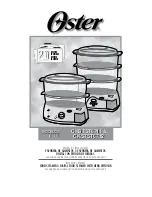
4
ENGLISH
1. Name of the parts
1. Pot handle
2. Safety opening
3. Pressure regulator (weight valve)
4. Lid
5. Safety valve
6. Lock
7. Lid handle
8. Gasket (not visible; inside the lid)
9. Pot
10. Pot handle
2.
IMPORTANT
SAFEGUARDS
When using pressure cookers, basic
safety precautions should always be
followed:
1. Read all instructions.
2. Do not touch hot surfaces. Use
handles or knobs.
3. Close supervision is necessary
when the pressure cooker is used
near children.
4. Do not place the pressure cooker
in a heated oven.
5. Extreme caution must be used
when moving a pressure cooker
containing hot liquids.
6. Do not use pressure cooker for
other than intended use.
7. The pressure cooker is pressured
by heat, and gets very hot. Improper
use may lead to burns or other
injuries. Make sure the pressure
cooker is properly closed before
operating. See section "Instructions
for use".
8. Do not fill the pressure cooker
2/3 of its capacity (see “MAX”
mark inside the pot). When
cooking foods that expand
during cooking such as rice,
dried vegetables or noodles,
do not fill the pressure cooker
above 1/3 of its capacity (see
“1/3” mark inside the pot). If
th
e pot is overfilled, parts of
ingredients such as bean skins,
noodles or other risk clogging
the vent pipe, which may lead
to build-up of excess pressure.
Do not use baking soda etc. that
have thermal reaction or a lot of
oil. See section “Instructions for
use”.
9. Please note that sticky
ingredients such as curry or
stew may get trapped inside
the safety device, hindering
proper pressure adjustment.
Make sure to remove the lid
after adding roux. Be aware
that certain foods, such as
applesauce, cranberries, pearl
barley, oatmeal or other cereals,
split peas, noodles, macaroni,
rhubarb, or spaghetti can foam,
froth, and sputter, and clog
the safety device (steam vent).
These foods should not be
cooked in a pressure cooker.
10. Always check the pressure
release device for clogging before
use. A clogged safety device may
lead to pressure build-up, which
could cause injuries. If necessary,
clean the safety device with a thin
rod, like a chopstick, and make sure
it moves freely. Remove any food
residue.
11. Do not open the pressure
cooker until the unit has cooled
and all internal pressure has
been released. If the handles
are difficult to push apart, this
indicates that the cooker is still
pressurized – do not force it
open. Any pressure in the cooker
can be hazardous. See section
"Instructions for use".
12. Do not use this pressure cooker
for pressure frying with oil.
Summary of Contents for VARDESATTA
Page 2: ......
Page 3: ...3 2 1 4 5 6 7 8 10 9...
Page 4: ......
Page 5: ...ENGLISH 4 16...
Page 17: ...15...
Page 18: ...16 1 1 2 3 4 5 6 7 8 9 10 2 1 2 3 4 5 6 7 8 3 2 MAX 3 1 1 3 9 10 11 12 13 14...
Page 20: ...18 6 9 4 10 4 10 4 7 7 10 8 3 I II 9 10 5 11 3 1 3 3 5 5 3 3 3 1 3 3 3...
Page 21: ...19 1 2 3 3 5 5 100 C 4 6 10 6 5 2 1 5 5 100 C 2 6 10 6 3 3 1 5 3 5 2 3 4 6 10 6...
Page 22: ...20 5 6 9 3 4 5 8 8 www IKEA com 9 1 2 3 4 1 3 2 3 3 4 4 5 6 3 5 1 2 8 www IKEA com 1 2 3 1 2...
Page 23: ...21 7 3 1 2 3 1 2 3 1 2 3 4 5 1 2 3 0 25L 4 5 1 2 1 2...
Page 28: ......
Page 29: ......







































